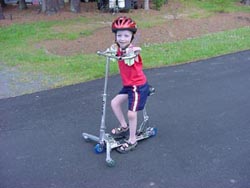Designers: Jeremy Kim, Miao Wang and Charles Tao
Client Coordinator: Lisa Mangino, PT
Supervising Professors: Richard Goldberg and Kevin Caves
 Our client is an active 7-year old boy with TAR syndrome, which causes him to have very short arms, and reduced dexterity in his legs. While his peers enjoy using scooters to ride around his neighborhood, this activity requires balancing on one foot while propelling with the other. Because of his disability, our client cannot use a commercial scooter. We modified a commercial scooter by adding forward outriggers, a side platform and wheel, a braking mechanism, handle bar extensions and pads, and a vertically adjustable seat. Our client can use the scooter on his neighborhood streets, allowing him to participate with his siblings and peers.
Our client is an active 7-year old boy with TAR syndrome, which causes him to have very short arms, and reduced dexterity in his legs. While his peers enjoy using scooters to ride around his neighborhood, this activity requires balancing on one foot while propelling with the other. Because of his disability, our client cannot use a commercial scooter. We modified a commercial scooter by adding forward outriggers, a side platform and wheel, a braking mechanism, handle bar extensions and pads, and a vertically adjustable seat. Our client can use the scooter on his neighborhood streets, allowing him to participate with his siblings and peers.
How this project helped
The modified scooter gives our client another means of riding a self-propelled device outdoors. The client’s mother commented, “The scooter … has really increased his inclusion in family activities outside. He always had to be put in a wagon, or helped greatly if we were going to walk around the block. Now, with his scooter, he can completely independently go around the block and require no assistance from the rest of the family. It gave him a great sense of pride to keep up with his other siblings as we either walk or ride bikes (and a scooter) around the block.”
The Modified Scooter (Figure 1) was constructed from a Razor brand scooter. Modifications included forward outriggers, a seat, a foot platform with side wheel, a steering mechanism, and brakes.
The outrigger frame was made from three pieces of 1” square, 1/8” thick aluminum tubing. The wheels, made from commercial casters, were bolted to this frame. To reduce rolling resistance, the plastic wheels that were originally mounted on the casters were replaced with low-friction skateboard wheels.
The seat mount was created by bolting the handlebar mount of a spare Razor scooter to the rear of the modified scooter frame. A standard bicycle seat and seat post were secured in the handlebar mount shaft.
The quick release mechanism of the handlebar mount allowed for simple and quick adjustments of the seat height.
To provide more surface for the client’s feet on the scooter, a platform was shaped from a 24 inch square piece of 1/8” thick aluminum sheet, and bolted to the scooter’s frame. A roller blade wheel was attached to the rear side of the plate, and a guard was attached to the top of the plate to prevent our client’s foot from contacting the wheel.
The steering mechanism of the original scooter was modified using two pairs of mountain bike handlebar extensions on each side. Each pair of extensions was first linked together in an “L” shape, and then attached to each end of the original handlebars. Cushioned pads were constructed from rounded wooden blocks covered with soft sponge, and bolted into the extensions.
A braking mechanism was created from a bicycle U-brake system, attached to the rear scooter wheel. The rubber brake pads were replaced with metal pads, to give a smoother braking operation. The hand lever from the bike brake was cut short and mounted on the scooter body, just in front of the foot platform, for accessibility with the right foot. A bicycle brake cable was connected between the lever and the U-brake at the rear wheel.
Cost of parts for the Modified Scooter was about $400.